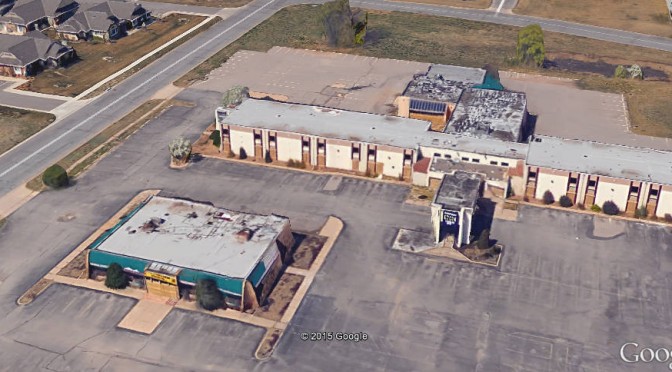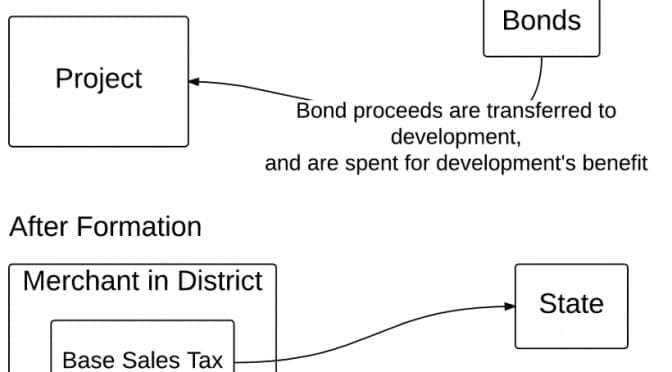From August 2012, an episode of cronyism in Wichita.
On Tuesday the Wichita City Council will consider the type of taxpayer-funded giveaway that voters have shown they don’t like. How council members vote may set the stage for city elections next March and April.
Tuesday’s item involves a proposed apartment development on the west bank of the Arkansas River across from the downtown WaterWalk development. The apartment developer is WaterWalk LLC, whose manager is Jack P. DeBoer.
The highlights of the deal include:
- The lease of 4.4 acres of city-owned land for $1 per year, for the next 93 years. City documents say the land is valued by Sedgwick County at $479,000. The city paid $919,695 to acquire the land in 1994 and 1995. It’s listed as for sale with an asking price of $1,153,344. The city is, however, asking the apartment developer to pay the full $93 in advance.
Development of an amphitheater, which was part of the WaterWalk master plan. Originally planned to be just west of WaterWalk Place, the condominium development on Main Street, the amphitheater will now be implemented as a floating stage in the Arkansas River. A $247,500 Economic Development Initiative (EDI) grant from the U.S. Department of Housing and Urban Development (HUD) will pay for a portion of the cost. Tuesday’s agenda item asks authorization to issue a request for proposal (RFP) for this stage.
Besides the sweetheart land lease, there are two other components of this deal that are troubling. One will undoubtedly be presented to city council members and the public as a big benefit to taxpayers, something that will actually profit the city. This is a provision that requires the apartment developer to pay “Additional Annual Rent.” Under this concept, each year the apartment developer will calculate “Adjusted Net Cash Flow” and remit 25 percent of that to the city.
To the casual observer, this seems like a magnanimous gesture by the apartment developer. It makes it look like the city has been a tough negotiator, hammering out a good deal for the city, letting citizens profit along with the apartment developer.
But the definition of cash flow includes a comprehensive list of expenses the may be deducted, including the cost of repaying any loans. There’s also an allowable expense called “Tenant Development Cost Return,” which is the apartment developer’s profit. The agreement defines this profit as 20 percent, and it’s deducted as part of the computation of “Adjusted Net Cash Flow.”
If there is ever any money left over after the dedication of all these expenses and profit margin, I will be surprised. Shocked, even. Here’s one reason why. One of the allowable deductions that goes into the computation of “Adjusted Net Cash Flow” is, according to city documents: “Amounts paid into any capital, furniture, fixture, equipment or other reserve.” There’s no restriction as to how much can be funneled into these reserve accounts. We can be sure that if this project was ever in the position where it looked like it might have to remit “Additional Annual Rent” to the city, contributions to these reserve funds would rise. Then, no funds paid to the city.
This is an example of the city appearing to be concerned for the welfare of taxpayers. In reality, this concept of “Additional Annual Rent” is worse than meaningless. It borders on deception.
Then, there’s this: The city has agreed to allow its ownership of the land (remember, the city is leasing the land to the apartment developer) to be subordinated to other debt the apartment developer may take on, such as the mortgage that will certainly be obtained. This means that if the apartment complex doesn’t succeed and there is foreclosure, the lender takes ownership of the city’s land.
Last week the city council passed a revision to its economic development policy that states that economic development incentives should have a cost-benefit ratio of at least 1.3 to one. No such number is given for this project.
Waterwalk, a problematic development
This deal is another chapter in the history of the troubled WaterWalk development. So far, WaterWalk has received some $41 million in public spending, and we have little to show for that investment.
Three years ago the Wichita Eagle editorialized: “Seven years into a project that was supposed to give Wichita a grand gathering place full of shops, restaurants and night spots as well as offices and condos, some City Council members and citizens remain skeptical at best about WaterWalk’s ability to deliver on its big promises. … True, the skepticism to date is richly deserved.” When our newspaper’s editorial board is critical of a government spending project in downtown Wichita, that’s a red letter day.
In 2009, after DeBoer took over the management of WaterWalk, the Wichita Eagle reported: “‘I’m not going down to City Hall with my hand out,’ DeBoer said. ‘I can’t. The city has put their money in it, and I’m happy with that. We’ve put a lot of our own money in and that’s OK. Now, time to deliver.’”
Leasing land worth $479,000 or $1,153,344 for one dollar per year: To me, that smells like a handout. It doesn’t sound like delivering on promises.
Around the time DeBoer took over the management of WaterWalk, Wichita city manager Robert Layton said no more public money would be put in to WaterWalk, according to Eagle reporting. Later he said those remarks were misinterpreted, with the Eagle reporting “[Layton] said the city won’t spend more on infrastructure, and that specific developments would be analyzed case by case to make sure they offer a return on investment for taxpayers and fit with the master plan.”
Wichita, home to cronyism
Measures like the city council will consider on Tuesday are what leads to cynicism regarding city government. It reinforces that notion that there is a network of insiders — the “good ol’ boy network” — that gets what it wants from city staff and officeholders. This deal — the sweetheart land giveaway, the deceptive appearance of profit sharing, the subordination of the city’s interests — doesn’t generate prosperity for Wichita and citizen confidence in its government. Instead, this deal contributes to the stench of cronyism that permeates and infests Wichita City Hall.
Two recent elections have shown that Wichitans don’t much care for this culture of giveaways to the politically connected class. People don’t like crony capitalism. They know it doesn’t work. The city defends these giveaways by saying they create jobs. But Wichita economic development is failing. Our city is not doing well, in spite of all the money spent on economic development efforts.
Additionally, when it is apparent that a “good ol’ boy” network of insiders exists at Wichita City Hall, it creates a toxic and corrosive political and business environment. Companies are reluctant to expand into areas where they don’t have confidence in the integrity of local government. Will I find my company bidding against a company that made bigger campaign contributions than I did? If I don’t make the right campaign contributions, will I get my zoning approved? Will my building permits be slow-walked through the approval process? Will my projects face unwarranted and harsh inspections?
Last year Charles Koch, chairman of the board and CEO of Wichita-based Koch Industries, wrote in the pages of the Wall Street Journal this regarding cronyism: “Government spending on business only aggravates the problem. Too many businesses have successfully lobbied for special favors and treatment by seeking mandates for their products, subsidies (in the form of cash payments from the government), and regulations or tariffs to keep more efficient competitors at bay. Crony capitalism is much easier than competing in an open market. But it erodes our overall standard of living and stifles entrepreneurs by rewarding the politically favored rather than those who provide what consumers want.”
WaterWalk and Jack DeBoer have already received generous financial assistance ($41 million) from the taxpayers of Wichita. That the city would consider even one dollar more is a scandal.
Amendments to Wichita WaterWalk Developer Agreements


 Besides this, do we really want to punish our guests with these taxes? A city tourism fee? Welcome to Wichita, indeed.
Besides this, do we really want to punish our guests with these taxes? A city tourism fee? Welcome to Wichita, indeed.

 An example used in the article is Toyota’s decision to move its North American headquarters to Plano. Toyota received incentives in conjunction. The article quotes Jim Lentz, CEO of Toyota North America, as saying “The incentives are really important.” But that hasn’t always been the line from Toyota.
An example used in the article is Toyota’s decision to move its North American headquarters to Plano. Toyota received incentives in conjunction. The article quotes Jim Lentz, CEO of Toyota North America, as saying “The incentives are really important.” But that hasn’t always been the line from Toyota.











